Free standing Monorail Cranes & Custom Monorail Crane System
Freestanding monorail cranes offer versatile material handling & custom monorail crane systems are tailored for specific operational needs. Get your design!
Category: Freestanding Bridge Crane
Your Trusted Overhead Crane Manufacturer & Supplier
Free Standing Monorail Cranes & Custom Monorail Crane System
Freestanding monorail cranes offer versatile material handling & custom monorail crane systems are tailored for specific operational needs. Get your design!
The Complete Guide to Freestanding Monorail Cranes: Efficiency and Precision in Industrial Lifting
Freestanding Monorail Cranes
Freestanding monorail cranes, also known as workstation monorail cranes or enclosed track monorail cranes, are a type of overhead lifting system characterized by their use of a single enclosed track (monorail) along which a hoist and trolley move. Unlike traditional bridge cranes that span larger areas, monorail cranes are designed to operate within defined workspaces, typically moving loads along a linear path.
The monorail track is typically made of steel and is enclosed to protect the trolley and hoist mechanism from contaminants such as dust and debris. This design ensures smoother movement and reduces wear on the components, enhancing the crane's longevity and reliability.
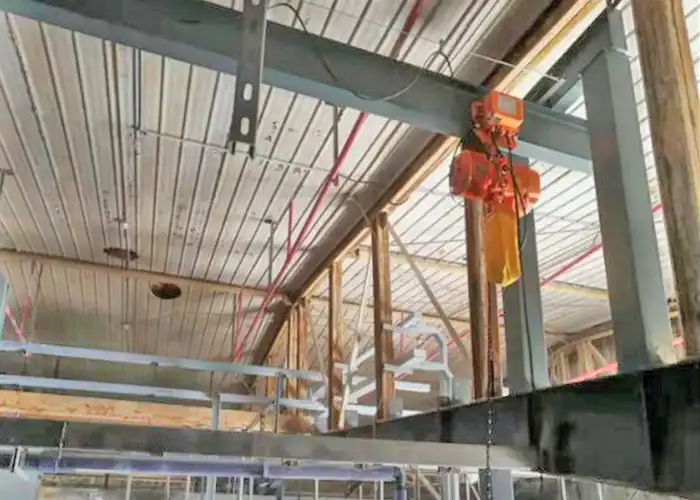
Freestanding monorail crane system with straight track
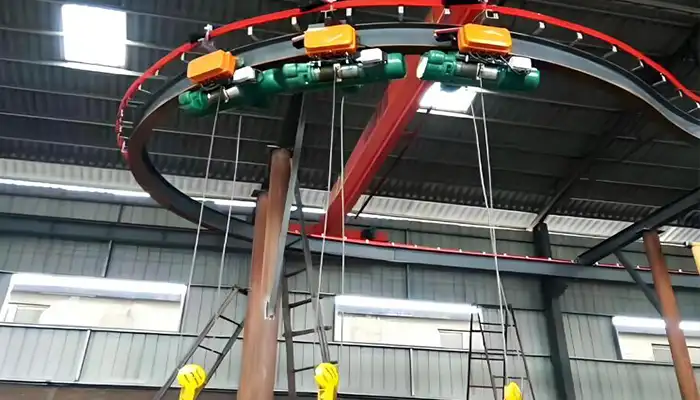
Freestanding monorail cranes with curved track or orbit
Importance in Industrial Settings
Freestanding monorail cranes play a crucial role in various industrial applications where precise load handling and movement are essential. They are particularly valued in environments such as:
- Manufacturing and Assembly Lines: Monorail cranes are ideal for transporting components and assemblies along production lines. Their ability to move loads precisely and repetitively aids in streamlining manufacturing processes and improving productivity.
- Maintenance and Repair Facilities: In maintenance workshops, monorail cranes facilitate the safe lifting and positioning of heavy equipment or machinery for servicing or repair. Their compact design and flexibility make them suitable for navigating around obstacles and accessing confined spaces.
- Warehouse and Logistics Operations: Within warehouses and distribution centers, monorail cranes efficiently manage the movement of goods and materials. They help optimize storage space utilization and support timely order fulfillment by transporting items to designated picking or packing areas.
These cranes are valued not only for their operational efficiency but also for their safety benefits. By keeping loads elevated and out of the way of ground-level operations, monorail cranes contribute to a safer working environment, reducing the risk of accidents and injuries associated with manual lifting and handling tasks.
Overall, freestanding monorail cranes are integral to enhancing workflow efficiency, minimizing downtime, and ensuring the safe handling of materials across a wide range of industrial sectors.
Design and Components
A freestanding monorail crane system is characterized by its straightforward yet effective design, tailored for specific industrial lifting needs within defined work areas. The system revolves around a single, enclosed track (monorail) that serves as the primary pathway for load movement. Here's a detailed look at its components:
Components
Monorail Track:
- Structure: Typically made from high-strength steel, the monorail track provides the guiding pathway for the crane's trolley and hoist system.
- Enclosed Design: Ensures the track is protected from environmental contaminants, enhancing longevity and minimizing maintenance needs.
- Track Layout: Configurations can vary from straight sections to curved tracks, depending on the layout and operational requirements of the workspace.
Trolley:
- Purpose: Mounted on the monorail track, the trolley serves as the carriage for the hoist.
- Movement: Moves along the length of the track, allowing precise positioning of the hoist and load within the defined work area.
- Types: Trolleys can be manual, electrically powered, or pneumatic, depending on the load capacity and operational preferences.
Hoist:
- Functionality: Attached to the trolley, the hoist performs the lifting and lowering of loads.
- Capacity: Available in various load capacities to accommodate different industrial requirements, ranging from light-duty to heavy-duty lifting.
- Safety Features: Often equipped with safety mechanisms such as limit switches, overload protection, and emergency braking systems to ensure safe operation.
Supports and Structure:
- Freestanding Design: Unlike bridge cranes that require overhead runways, freestanding monorail cranes are supported by floor-mounted columns or supports.
- Stability: Columns are securely anchored to the floor to provide stability and support the weight of the monorail track, trolley, hoist, and lifted loads.
- Configuration: Supports can be configured to fit the layout of the workspace, optimizing operational efficiency and safety.
Integration and Customization
- Modularity: Monorail crane systems are modular, allowing for easy customization and expansion as operational needs evolve.
- Configurability: Systems can be tailored with additional features such as pendant controls, variable speed drives for trolleys, and automated controls for enhanced precision and efficiency.
Advantages of Design
- Space Efficiency: Compact design makes optimal use of vertical space, ideal for facilities with limited ceiling height.
- Versatility: Adaptable to various industrial applications, from assembly lines to maintenance workshops, due to their precise load handling capabilities.
- Ease of Installation: Floor-mounted supports simplify installation compared to overhead runway systems, reducing downtime during setup.
The design and components of freestanding monorail cranes is crucial for assessing their suitability and benefits in different industrial environments. Each component plays a vital role in ensuring efficient and safe operation, contributing to enhanced productivity and workflow optimization.
If you have further questions or need more details on any specific component or aspect of monorail cranes, feel free to ask!
Types of Freestanding Monorail Cranes
Freestanding monorail cranes are independent material handling systems supported by their own columns, making them versatile for various industrial applications. They come in two primary types based on the track design: straight and curved.
- Freestanding Monorail Cranes with Straight Track: feature a single, straight beam supported by columns. They offer precise, linear movement, ideal for assembly lines, warehouses, and straightforward manufacturing processes. Their simplicity, cost-effectiveness, and ease of installation make them suitable for tasks requiring direct, linear transport.
- Freestanding Monorail Cranes with Curved Track: include beams with curves and bends, allowing the crane to navigate around obstacles and through different facility sections. This type is perfect for complex layouts, production cells, and versatile material handling needs. Although more flexible and adaptable, they are typically more complex and costly to install and maintain compared to straight track systems.
Choosing between these types depends on the facility's layout and specific material handling requirements, balancing simplicity with flexibility.

Freestanding Monorail Cranes with Straight Track:
Structure:
- Beam Design: Consists of a single, straight girder or beam supported by freestanding columns.
- Support Columns: Columns are placed at intervals along the track to support the beam and the load.
Movement:
- Linear Path: The hoist and trolley move along a straight line, providing straightforward, linear material handling.
- Fixed Path: Movement is restricted to the length of the straight track.
Applications:
- Assembly Lines: Ideal for moving materials along a production line.
- Warehouses: Useful for transporting goods in a straight path from one point to another.
- Manufacturing Processes: Suitable for repetitive tasks that require linear movement.
Advantages:
- Simplicity: Easier to design, install, and maintain due to the straightforward structure.
- Cost-Effective: Generally less expensive than more complex track systems.
- Precision: Provides precise and predictable movement along a fixed path.
Disadvantages:
- Limited Flexibility: Restricted to straight-line movement, which may not be suitable for all material handling needs.
- Space Constraints: Requires a clear, unobstructed path along the length of the track.
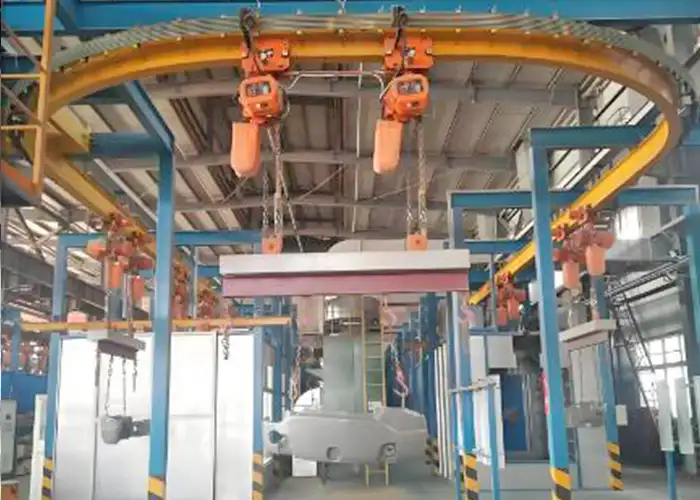
Freestanding Monorail Cranes with Curved Track:
Structure:
- Beam Design: Consists of a beam or series of beams that can include curves and bends.
- Support Columns: Columns are strategically placed to support the curved track, ensuring stability and load capacity.
Movement:
- Curved Path: The hoist and trolley can move along a track that includes curves, bends, and changes in direction.
- Flexible Path: Allows for more complex movement patterns, navigating around obstacles and through various areas of a facility.
Applications:
- Complex Layouts: Suitable for facilities with irregular layouts where straight-line movement is not practical.
- Production Cells: Useful for transporting materials between different production cells or workstations.
- Loading and Unloading: Ideal for moving materials around corners, through different sections of a warehouse, or between different areas.
Advantages:
- Flexibility: Can be customized to fit complex layouts and navigate around obstacles.
- Versatile Movement: Allows for more versatile material handling, accommodating various facility designs.
- Increased Coverage: Provides better coverage of the workspace, reaching areas that straight tracks cannot.
Disadvantages:
- Complexity: More complex design and installation compared to straight tracks.
- Cost: Generally more expensive due to the customized nature of the curved track and additional support requirements.
- Maintenance: May require more frequent maintenance to ensure smooth operation along the curves.
Summary:
| Feature | Freestanding Monorail Cranes with Straight Track | Freestanding Monorail Cranes with Curved Track |
|---|---|---|
| Structure | Single, straight girder with support columns | Beam with curves and bends, supported by columns |
| Movement | Linear along a fixed, straight path | Flexible, along a curved and potentially complex path |
| Applications | Assembly lines, linear transport | Complex layouts, production cells, varied transport |
| Advantages | Simplicity, cost-effective, precise movement | Flexibility, versatile movement, increased coverage |
| Disadvantages | Limited to straight-line movement | More complex, higher cost, increased maintenance |
Choosing between these types of freestanding monorail cranes depends on the specific requirements of the facility, including the layout, material handling needs, and budget constraints.
Advantages of Freestanding Monorail Cranes
Freestanding monorail cranes offer several distinct advantages that make them a preferred choice in industrial lifting applications. Here's a detailed exploration of their key benefits:
Space Efficiency: Lower Ceiling Height Requirements
- Compact Design: Monorail cranes utilize a single, enclosed track (monorail) that requires less overhead clearance compared to traditional bridge cranes with dual runways.
- Optimized Vertical Space: Ideal for facilities with lower ceiling heights or limited vertical space, allowing efficient use of available overhead space without compromising on lifting capacity or operational efficiency.
- Minimized Obstructions: By keeping the load handling mechanism within a confined space, monorail cranes reduce obstruction of floor-level activities and traffic, enhancing overall workspace usability.
Flexibility in Design and Installation
- Adaptability to Layouts: Monorail crane systems can be customized to fit specific layout requirements of industrial environments, including straight or curved track configurations.
- Installation Versatility: Floor-mounted supports provide flexibility in installation, accommodating existing facility layouts and operational workflows without extensive structural modifications.
- Ease of Integration: Simplified integration into both new and existing buildings, minimizing disruption during installation and ensuring faster deployment compared to more complex crane systems.
Modular and Expandable Configurations
- Scalability: Modular design allows for incremental expansion of the crane system as operational needs grow, making it cost-effective and adaptable to evolving production demands.
- Customization Options: Components such as trolleys, hoists, and controls can be easily upgraded or added to meet changing requirements without replacing the entire system.
- Operational Efficiency: Expandable configurations enable efficient handling of varying load capacities and operational scenarios, optimizing resource utilization and enhancing productivity.
Enhanced Operational Benefits
- Precise Load Handling: Monorail cranes facilitate precise positioning and movement of loads along a defined path, reducing handling times and minimizing errors in manufacturing and assembly processes.
- Improved Safety: Elevated load handling minimizes risks associated with manual lifting and transport, promoting a safer working environment and reducing potential workplace injuries.
- Maintenance Accessibility: Accessible track and component design simplifies maintenance tasks, allowing for timely inspections and repairs to ensure continuous operational reliability.
Economic and Environmental Considerations
- Energy Efficiency: Efficient motorized trolleys and hoists contribute to lower energy consumption compared to larger, more power-intensive crane systems.
- Operational Cost Savings: Reduced installation complexity and maintenance requirements translate into lower overall operational costs over the crane system's lifecycle.
Freestanding monorail cranes combine space efficiency, design flexibility, and modular scalability to deliver reliable performance and operational benefits across various industrial settings. Their ability to optimize space utilization, adapt to changing needs, and enhance workplace safety makes them a versatile solution for modern manufacturing, maintenance, and logistics operations.
If you have further questions or need additional details on any specific advantage or aspect of monorail cranes, feel free to ask!
Applications in Various Industries
Freestanding monorail cranes find wide-ranging applications across diverse industrial sectors, where their compact design, precise load handling capabilities, and operational flexibility prove advantageous. Here's an in-depth look at their applications in key industries:
Manufacturing and Assembly Lines
- Efficient Material Handling: Monorail cranes streamline material flow and component handling along assembly lines, facilitating smooth production processes.
- Workstation Integration: Ideal for workstation use, where they enable operators to move parts and assemblies between workstations with precision and ease.
- Just-in-Time Manufacturing: Supports lean manufacturing practices by reducing material handling times and enhancing workflow efficiency.
Maintenance and Repair Facilities
- Equipment Handling: Essential for lifting and positioning heavy machinery and equipment during maintenance and repair operations.
- Access to Confined Spaces: Compact design allows maneuverability in tight spaces, facilitating access to machinery and components for servicing.
- Safety in Maintenance: Elevated load handling reduces risks associated with manual lifting, enhancing workplace safety for maintenance personnel.
Warehouse and Logistics Operations
- Inventory Management: Enables efficient movement of goods within warehouses and distribution centers, optimizing storage and retrieval processes.
- Order Fulfillment: Facilitates rapid and accurate order picking and packing by transporting items to designated shipping areas or packing stations.
- Cross-Docking Efficiency: Supports quick transfer of goods between inbound and outbound trucks, minimizing handling times and enhancing logistics efficiency.
Additional Industry Applications
- Automotive Manufacturing: Used for handling vehicle components, subassemblies, and finished products along production lines.
- Aerospace and Defense: Facilitates assembly and maintenance of aircraft components and systems, ensuring precision and adherence to strict safety standards.
- Food and Beverage Processing: Enables hygienic handling of materials and products in compliance with food safety regulations.
Advantages Across Industries
- Versatility: Adaptable to various load types and operational environments, from heavy-duty industrial components to delicate materials.
- Customization: Can be tailored with specialized hoists, controls, and accessories to meet specific industry requirements and operational demands.
- Integration with Automation: Compatible with automated systems for enhanced productivity and seamless integration into smart manufacturing environments.
Freestanding monorail cranes play a critical role in enhancing operational efficiency, safety, and productivity across manufacturing, maintenance, and logistics sectors. Their ability to optimize workflow, reduce downtime, and improve workplace ergonomics makes them a valuable investment for modern industrial facilities.
If you have specific questions about how monorail cranes are applied in a particular industry or need further details on their functionalities, feel free to ask!
Comparative Analysis with Other Crane Types
Freestanding monorail cranes offer distinct advantages over other types of crane systems commonly used in industrial applications. Here's a comparative analysis highlighting their differences and benefits compared to freestanding bridge cranes, traditional jib cranes, and gantry cranes:
Contrasting with Freestanding Bridge Cranes
Freestanding Monorail Cranes & Freestanding Bridge Cranes
The distinction between "Freestanding Monorail Cranes" and "Freestanding Bridge Cranes" typically lies in their design and functionality:
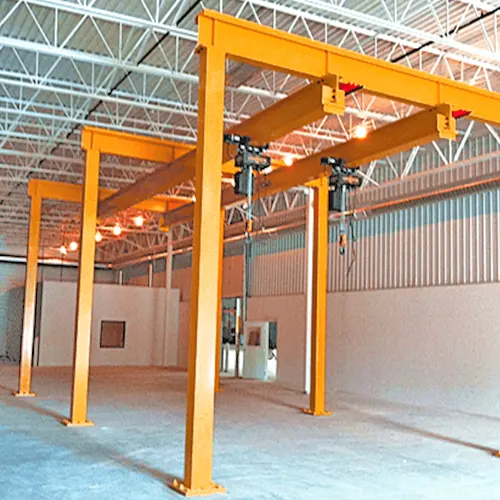
Freestanding Monorail Cranes:
Structure: These cranes are typically comprised of a single girder or beam supported by freestanding support columns. They do not require attachment to the building's structure and can be installed independently within a facility.
Movement: Freestanding monorail cranes move along the length of the monorail beam, allowing them to cover a linear path. They are suitable for moving loads in a straight line.
Applications: Commonly used in manufacturing environments, assembly lines, and workshops where materials or products need to be transported in a linear direction. They are ideal for tasks that do not require complex movement patterns and where overhead or ceiling-mounted options are not feasible.
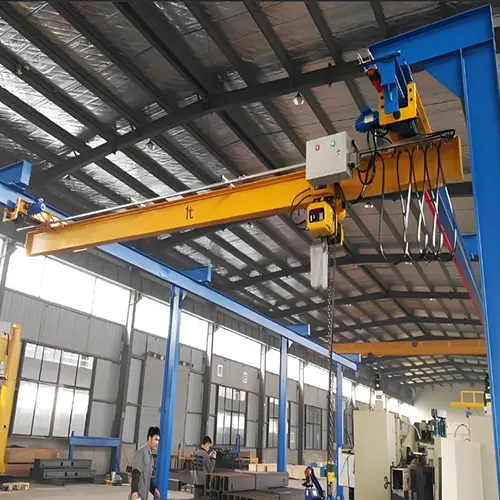
Freestanding Bridge Cranes:
Structure: These cranes feature one or more girders (single or double) supported by freestanding columns or posts, forming a bridge-like structure. The entire system is independent of the building's structure.
Movement: Freestanding bridge cranes move along elevated runways or rails that span between the support columns. They provide both longitudinal (forward and backward) and lateral (side-to-side) movement capabilities.
Applications: Used in various industrial settings where there is a need to handle heavier loads and cover larger work areas. They are suitable for applications requiring versatile movement patterns and the ability to move loads across different sections of a facility.
Key Differences:
Structure: Freestanding monorail cranes have a single beam supported by columns, offering a simpler and more linear movement path. Freestanding bridge cranes have one or more girders supported by columns, providing a bridge structure for more complex movement.
Movement Path: Freestanding monorail cranes move along a linear path on the single beam, while freestanding bridge cranes offer movement along both longitudinal and lateral axes, allowing them to cover larger and more complex areas.
Applications: Freestanding monorail cranes are suited for straightforward linear material handling tasks, while freestanding bridge cranes are designed for more demanding applications requiring versatile movement and handling of heavier loads.
Comparison Table: Freestanding Monorail Cranes vs. Freestanding Bridge Cranes
| Feature | Freestanding Monorail Cranes | Freestanding Bridge Cranes |
|---|---|---|
| Structure | Single girder or beam supported by columns | One or more girders (single or double) supported by columns, forming a bridge structure |
| Movement | Linear along a fixed, straight or curved path | Longitudinal (along the rails) and lateral (across the bridge) movement |
| Support | Freestanding columns | Freestanding columns |
| Applications | Assembly lines, linear material transport, manufacturing | Heavy lifting, large area coverage, complex movement patterns |
| Load Capacity | Typically lighter loads | Higher load capacity, suitable for heavier loads |
| Space Utilization | Maximizes overhead space, minimal floor footprint | Requires more overhead space, larger floor footprint |
| Flexibility | Linear paths, customizable with straight or curved tracks | Versatile movement, can cover large and complex areas |
| Installation Complexity | Simpler installation, less structural complexity | More complex installation due to bridge structure |
| Cost | Generally more cost-effective | Higher cost due to more complex structure and higher load capacity |
| Maintenance | Easier and less frequent maintenance | More maintenance required due to complex structure |
| Ideal Use Cases | Straight-line material handling, restricted space | Heavy industrial applications, large facilities with diverse movement needs |
This table provides a clear comparison between freestanding monorail cranes and freestanding bridge cranes, highlighting their structural differences, movement capabilities, applications, load capacities, and other key features.
Structure and Mobility:
- Monorail Cranes: Utilize a single enclosed track (monorail) for trolley and hoist movement along a fixed path within a defined workspace.
- Bridge Cranes: Feature dual parallel runways with a bridge spanning between them, providing extensive coverage and the ability to move loads across a larger area.
Space Utilization:
- Monorail Cranes: Require less overhead clearance due to their single track design, making them suitable for facilities with lower ceiling heights.
- Bridge Cranes: Need more vertical space for the bridge to traverse and lift loads, limiting their application in spaces with height restrictions.
Flexibility and Adaptability:
- Monorail Cranes: Excel in applications where loads follow a linear path or specific routing within a workstation or production line.
- Bridge Cranes: Offer greater flexibility in handling loads across wider spans and varied work areas, making them ideal for large-scale manufacturing and assembly operations.
Installation and Cost Considerations:
- Monorail Cranes: Typically easier and quicker to install with minimal structural modifications, reducing installation downtime and costs.
- Bridge Cranes: Require substantial overhead structural support and installation time, potentially increasing initial setup costs and operational disruptions.
Advantages over Free Standing Jib Cranes and Free Standing Gantry Cranes
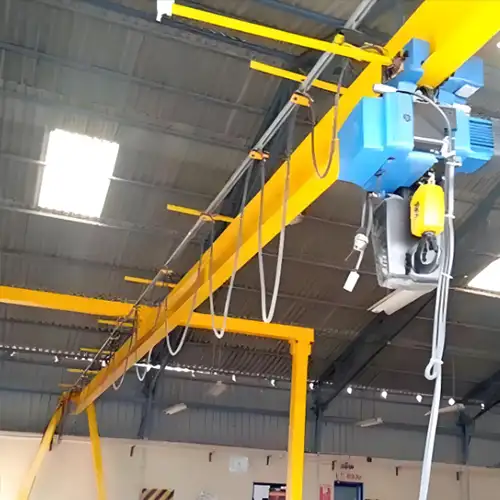
Free Standing Monorail Cranes:
Advantages:
Linear Movement:
Precise Path: Ideal for applications requiring straight-line movement, providing a clear and precise path for materials handling.
Ease of Automation: Simplifies automation and control for repetitive processes along a fixed route.
Space Efficiency:
Overhead Space Utilization: By utilizing overhead space, these cranes free up valuable floor space, making them suitable for facilities with limited ground area.
Minimal Footprint: The support columns take up minimal space, allowing more flexibility in floor layout and work area design.
Flexibility in Layout:
Customizable Path: Can be designed to fit specific operational needs, including curves and switches for complex material handling paths.
Expandable: Easily extendable by adding more beams or altering the path as operational requirements change.
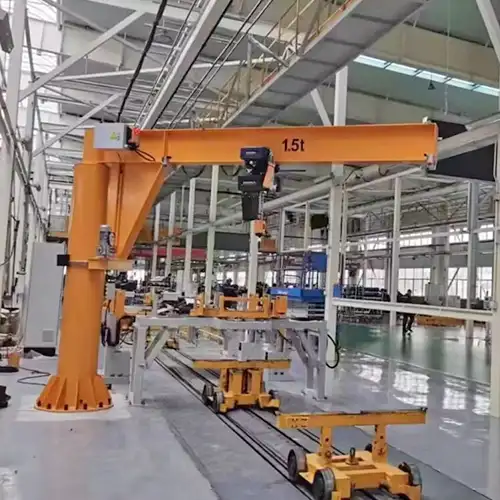
Comparison Disadvantages:
Limited Coverage:
Restricted Range: Jib cranes typically offer a limited range of motion, covering only a circular area around their base.
Height Constraints: Height and reach are often constrained by the design, limiting the overall working area.
Space Utilization:
Ground Obstruction: The base of a jib crane occupies floor space, potentially obstructing workflows and reducing usable ground area.
Less Efficient Overhead Use: Does not utilize overhead space as effectively as monorail cranes, which can cover more area without ground interference.
Capacity and Reach:
Load Limits: Generally designed for lighter loads compared to monorail cranes, which can handle heavier materials.
Reach Limitations: The reach of a jib crane is limited by the length of its boom, which may not be sufficient for some applications.
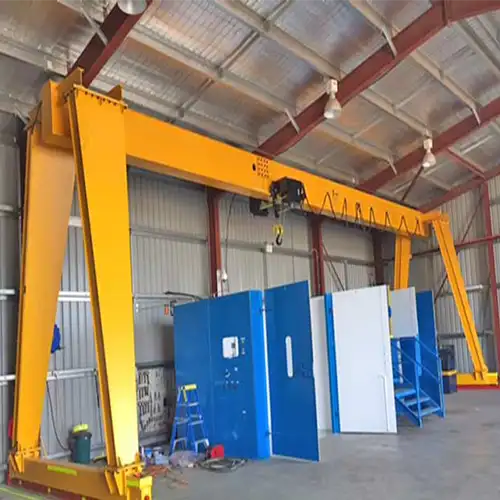
Comparison Disadvantages:
Movement and Maneuverability:
Ground-Level Movement: Gantry cranes move on wheels or tracks at ground level, which can be less efficient for facilities needing overhead solutions.
Floor Space Requirement: Requires clear and level floor space for movement, potentially interfering with other ground-level operations.
Space Utilization:
Footprint: Gantry cranes have a larger footprint due to their supporting legs and movement requirements, which can reduce available floor space.
Overhead Constraints: Does not fully utilize overhead space, unlike monorail cranes that maximize vertical space.
Installation and Flexibility:
Setup Complexity: Installation of gantry cranes can be more complex due to the need for a level and strong foundation, particularly for larger units.
Less Customizable Path: Typically move in straight lines or fixed paths, offering less flexibility compared to the customizable paths of monorail systems.
Free Standing Monorail Cranes offer distinct advantages in terms of precise linear movement, efficient use of overhead space, and flexibility in layout customization. Compared to Free Standing Jib Cranes, they provide broader coverage and better space utilization. Compared to Free Standing Gantry Cranes, they offer superior overhead space utilization and less interference with ground-level operations. These advantages make monorail cranes a highly effective solution for specific material handling needs in various industrial environments.
Comparasion
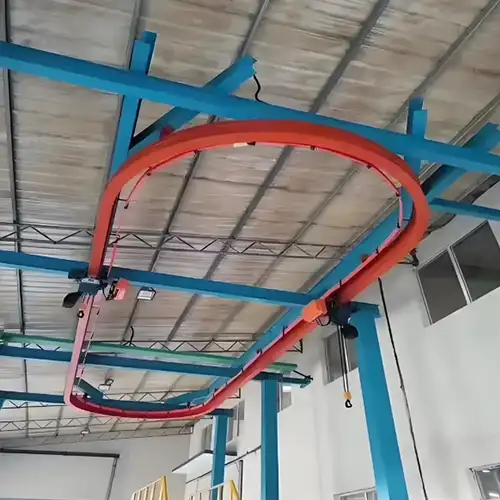
Free Standing Monorail Cranes:
Structure:
- Single girder or beam supported by freestanding columns.
- Overhead space utilization, with minimal floor footprint.
Movement:
- Linear movement along a fixed path.
- Ideal for transporting materials in a straight line.
Applications:
- Assembly lines, manufacturing processes, and warehouses.
- Suitable for tasks requiring precise, linear material handling.
Advantages:
- Space Efficiency: Maximizes overhead space, freeing up floor space.
- Flexibility: Customizable paths, expandable layout.
- Ease of Automation: Simplifies automation along a fixed route.
- Minimal Obstruction: Minimal interference with ground operations.
Disadvantages:
Limited Movement: Restricted to linear paths, not suitable for complex movement patterns.

Free Standing Jib Cranes:
Structure:
- Consists of a vertical mast and a horizontal boom (jib) that supports the lifting mechanism.
- Mounted on a base plate or foundation.
Movement:
- Rotary movement, usually 180° to 360° around the mast.
- Limited vertical and horizontal reach.
Applications:
- Workstations, manufacturing cells, and loading docks.
- Ideal for repetitive lifting tasks in a defined circular area.
Advantages:
- Ease of Use: Simple operation and quick installation.
- Compact Design: Small footprint, suitable for tight spaces.
- Cost-Effective: Generally lower cost compared to other crane types.
Disadvantages:
- Limited Range: Restricted movement to a circular area.
- Load Capacity: Typically handles lighter loads compared to other cranes.
- Height and Reach Constraints: Limited by the length of the boom.

Free Standing Gantry Cranes:
Structure:
- Consists of a bridge supported by two freestanding legs, which move on wheels or tracks.
- Can be portable or fixed in one location.
Movement:
- Both longitudinal (along the rails) and lateral (across the bridge) movement.
- Can cover larger work areas.
Applications:
- Warehouses, construction sites, and outdoor yards.
- Suitable for heavy lifting tasks and moving large loads across open spaces.
Advantages:
- Versatile Movement: Covers large areas with longitudinal and lateral movement.
- Load Capacity: Can handle heavier loads than jib and monorail cranes.
- Flexibility: Portable versions offer mobility for various tasks.
Disadvantages:
- Floor Space Requirement: Requires clear and level floor space for movement.
- Installation Complexity: More complex setup, particularly for larger units.
- Footprint: Larger footprint can obstruct other ground-level operations.
Summary Comparison:
| Feature | Free Standing Monorail Cranes | Free Standing Jib Cranes | Free Standing Gantry Cranes |
|---|---|---|---|
| Structure | Single girder, freestanding columns | Vertical mast, horizontal boom | Bridge, freestanding legs, wheels or tracks |
| Movement | Linear along a fixed path | Rotary around the mast (180°-360°) | Longitudinal and lateral on rails or wheels |
| Applications | Linear material handling in assembly lines, etc. | Workstations, loading docks | Warehouses, construction sites, outdoor yards |
| Advantages | Space-efficient, customizable, minimal obstruction | Compact, cost-effective, easy to use | Versatile movement, heavy load capacity, mobility |
| Disadvantages | Limited to linear paths | Limited range and load capacity, height constraints | Requires clear floor space, complex installation |
| Ideal Use Cases | Assembly lines, straight-line material transport | Repetitive tasks in a circular area | Large area coverage, heavy lifting tasks |
This comparison highlights the specific strengths and limitations of each crane type, helping in selecting the most suitable one based on operational needs, spatial constraints, load capacities, and movement requirements within industrial environments.
Key Considerations for Choosing a Monorail Crane
Choosing the right monorail crane involves assessing several critical factors to ensure it meets operational requirements and enhances workplace efficiency. Here are key considerations to keep in mind:
Load Capacity and Lifting Requirements
- Identify Load Characteristics: Determine the types of loads to be lifted, including weight, dimensions, and frequency of handling.
- Hoist Capacity: Select a monorail crane system with a hoist capacity that comfortably exceeds the maximum weight of your heaviest load to ensure safe and efficient lifting operations.
- Consider Load Dynamics: Factor in load movement requirements, such as lifting speed, acceleration, and deceleration, to match crane capabilities with operational demands.
Workspace Layout and Overhead Clearance
- Evaluate Space Constraints: Measure available floor space and vertical clearance to determine the optimal monorail track layout and crane configuration.
- Track Design: Choose between straight, curved, or custom-configured tracks based on workspace layout and load handling paths.
- Clearance Requirements: Ensure sufficient overhead clearance for the monorail track, trolley, and lifted loads to prevent collisions with obstacles and ensure safe operation.
Operational and Maintenance Considerations
- Operational Requirements: Assess operational frequency, shifts, and peak load periods to select a monorail crane system capable of meeting production demands without compromising efficiency.
- Control System: Evaluate control options, such as pendant controls, radio remotes, or automated systems, to optimize operator efficiency and load handling precision.
- Maintenance Accessibility: Consider ease of access to components for routine inspections, maintenance, and repairs to minimize downtime and ensure continuous operation.
- Safety Features: Prioritize cranes equipped with safety features such as overload protection, emergency stop functions, and limit switches to safeguard personnel and equipment during operation.
Integration with Existing Infrastructure
- Compatibility: Ensure compatibility with existing building structures and utility services (electrical, ventilation) to facilitate seamless installation and integration.
- Future Expansion: Select a modular monorail crane system that supports future expansion or upgrades to accommodate evolving production needs and technological advancements.
- Environmental Factors: Consider environmental conditions (e.g., temperature, humidity) and regulatory requirements that may impact crane performance and longevity.
Cost Considerations
- Initial Investment: Evaluate upfront costs, including crane system purchase, installation, and any necessary infrastructure modifications.
- Total Cost of Ownership: Factor in ongoing operational expenses, maintenance costs, energy consumption, and potential productivity gains to assess long-term cost-effectiveness.
By carefully evaluating these key considerations, businesses can make informed decisions when selecting a monorail crane system that aligns with their operational goals, enhances workplace safety, and optimizes efficiency across industrial applications.
If you have specific questions or need further details on any aspect of choosing a monorail crane, feel free to ask!
Installation and Safety Standards
Installing a freestanding monorail crane involves careful planning and adherence to safety standards to ensure efficient operation and compliance with regulatory requirements. Here's a detailed exploration of the installation process, requirements, safety features, and regulations:
Installation Process and Requirements
- Site Assessment: Conduct a thorough assessment of the installation site to determine space availability, floor condition, and overhead clearance necessary for the monorail track, trolley, and hoist.
- Structural Considerations: Ensure floor-mounted supports or columns are correctly positioned and securely anchored to support the weight of the crane system and anticipated loads.
- Track Configuration: Select and install the appropriate monorail track configuration (straight, curved, or custom-designed) based on workspace layout and operational requirements.
- Electrical and Mechanical Integration: Coordinate electrical wiring and mechanical connections to power the hoist, trolley, and any automated control systems, ensuring compatibility with existing infrastructure.
Safety Features and Regulations
- Safety Standards: Comply with local and national safety standards and regulations governing the installation, operation, and maintenance of overhead lifting equipment (e.g., OSHA regulations in the United States).
- Emergency Stop Systems: Install emergency stop buttons or switches at strategic locations to immediately halt crane operations in case of emergencies or unsafe conditions.
- Overload Protection: Equip the hoist with overload protection devices to prevent lifting loads beyond rated capacities, safeguarding against structural damage and worker injuries.
- Limit Switches: Implement limit switches to automatically stop crane movement when the trolley reaches predefined travel limits, preventing collisions and ensuring safe operation within designated areas.
- Safety Audits and Inspections: Conduct regular safety audits and inspections of the monorail crane system, including track alignment, mechanical components, and electrical systems, to identify and address potential hazards or operational issues promptly.
Operator Training: Provide comprehensive training for crane operators and maintenance personnel on safe operating procedures, emergency protocols, and equipment maintenance practices to enhance workplace safety and minimize risks.
Environmental Considerations
- Environmental Controls: Implement measures to protect the crane system from adverse environmental conditions such as temperature extremes, humidity, and corrosive substances that could affect performance and longevity.
- Ventilation and Air Quality: Ensure adequate ventilation in enclosed workspaces to maintain air quality and minimize dust accumulation, which can impact crane operation and maintenance.
Documentation and Compliance
- Installation Documentation: Maintain detailed records of the installation process, including equipment specifications, structural calculations, and safety certifications, to demonstrate compliance with regulatory requirements.
- Certification and Licensing: Obtain necessary certifications and licenses for crane operation and ensure periodic renewal to remain compliant with regulatory standards and industry best practices.
By prioritizing safety during installation and adhering to established standards and regulations, businesses can mitigate risks, enhance operational efficiency, and promote a safe working environment when using freestanding monorail cranes.
If you have further questions or need additional details on any specific aspect of installation or safety standards for monorail cranes, feel free to ask!
Case Studies and Practical Examples
Examining real-world applications and challenges encountered in the use of freestanding monorail cranes provides valuable insights into their effectiveness and versatility across various industries. Here are case studies and practical examples highlighting their applications, successes, challenges, and solutions:
Applications and Success Stories
Manufacturing and Assembly Lines:
- Application: A automotive manufacturing plant implemented monorail cranes to streamline assembly line processes, transporting vehicle components such as engines and chassis along designated workstations.
- Success: Improved production efficiency by reducing material handling times and enhancing workflow continuity, contributing to increased output and quality control.
Maintenance and Repair Facilities:
- Application: In a heavy equipment maintenance facility, monorail cranes were utilized for lifting and maneuvering large machinery and components during servicing operations.
- Success: Enhanced safety for maintenance personnel by minimizing manual lifting and improving accessibility to equipment, leading to reduced downtime and accelerated maintenance cycles.
Warehouse and Logistics Operations:
- Application: A distribution center integrated monorail cranes for sorting and distributing packaged goods across multiple storage aisles and loading docks.
- Success: Optimized inventory management and order fulfillment processes through efficient load handling and precise positioning, supporting just-in-time delivery schedules and customer satisfaction.
Challenges Faced and Solutions Implemented
Space Constraints:
- Challenge: Limited floor space and overhead clearance posed challenges for installing monorail tracks in compact manufacturing facilities.
- Solution: Custom-designed track configurations, including curved tracks and modular supports, were implemented to maximize use of available space and ensure seamless integration into existing production layouts.
Load Capacity and Handling Requirements:
- Challenge: Variations in load sizes and weights required adaptable crane systems capable of handling diverse materials and components.
- Solution: Upgraded hoist capacities and versatile trolley designs were deployed to accommodate heavy-duty lifting requirements while maintaining precision and operational flexibility.
Environmental Factors:
- Challenge: Harsh environmental conditions, such as high humidity or temperature fluctuations, posed operational challenges for crane components and structural integrity.
- Solution: Enhanced environmental controls and corrosion-resistant materials were incorporated into crane designs to mitigate adverse effects and ensure long-term reliability in challenging work environments.
Lessons Learned and Best Practices
- Continuous Improvement: Regular performance assessments and feedback from operators and maintenance teams facilitate continuous improvement and optimization of crane systems.
- Safety Emphasis: Prioritizing operator training, adherence to safety protocols, and proactive maintenance schedules are critical for maintaining a safe working environment and minimizing operational risks.
- Adaptability: Flexibility in system design and configuration allows for scalability and adaptation to evolving production needs and technological advancements.
Conclusion
Freestanding monorail cranes represent a versatile and efficient solution for industrial lifting and material handling applications. Throughout this guide, we've explored their benefits, applications across various industries, key considerations for selection, and practical examples. Here's a concise summary and final considerations for choosing a monorail crane:
Summary of Benefits and Applications
Freestanding monorail cranes offer several key benefits:
- Space Efficiency: Utilize vertical space effectively with minimal floor obstruction, making them suitable for facilities with lower ceiling heights.
- Precision and Flexibility: Enable precise load handling along a defined path, supporting streamlined manufacturing, assembly, and logistics operations.
- Safety: Enhance workplace safety by reducing manual handling risks and integrating robust safety features such as overload protection and emergency stop systems.
- Adaptability: Configurable designs accommodate diverse operational layouts and evolving production needs, supporting scalability and future expansions.
Final Considerations for Selecting a Monorail Crane
When selecting a monorail crane, consider the following factors:
- Load Capacity: Match hoist capacity and load handling capabilities to operational requirements, ensuring efficient and safe lifting operations.
- Workspace Layout: Evaluate available space, overhead clearance, and track configuration options to optimize crane installation and integration into existing facilities.
- Operational Efficiency: Choose control systems and automation features that enhance operator productivity, minimize downtime, and support operational continuity.
- Safety Standards: Adhere to regulatory safety standards and implement comprehensive safety measures to protect personnel, equipment, and operational integrity.
- Lifecycle Costs: Assess total cost of ownership, including initial investment, maintenance expenses, and potential productivity gains, to determine long-term cost-effectiveness.
In conclusion, freestanding monorail cranes are a reliable choice for enhancing workflow efficiency, improving workplace safety, and achieving operational excellence in manufacturing, maintenance, and logistics environments. By selecting the right monorail crane system tailored to specific application needs and operational demands, businesses can optimize productivity, mitigate risks, and foster sustainable growth in industrial operations.
If you have further questions or need additional guidance on selecting a monorail crane, feel free to reach out!
Related Products

Latest project
150 Ton Overhead Crane Installation Feedback – Paraguay Case
QDX 150 ton overhead crane in action in Paraguay. Installation photos, video, and client feedback show performance, safety, and heavy-lifting efficiency.
Free consultation to Confirm Parameters & Specifications and Get
Latest Crane Price & Crane Rate.
- Types of overhead cranes : _______?
- Optional: Overhead travelling crane, goliath gantry crane,Slewing jib crane, Single girder or double girder crane,small portable crane or kbk crane, etc.
- Capacity of overhead crane: _______?
- Optional: 0.25ton, 0.5 ton, 1 ton, 2 ton, 3ton, 5 ton, 10 ton,15ton, 20ton, 25 ton, 30ton,35ton, up to 550ton, etc.
- Crane span & lifting height : _______?
- Crane travelling length : _____?
- Control of overhead crane:_______?
- Optional: pendant/ remote/cabin control
- Voltage supply of overhead crane:_____?
- Eg,: 380V50/60HZ,3Phase or others,etc.
- Application/usage of crane:_______?
- Eg,: Steel mill, ,injection mold, cement,stone, concrete,granite, general manufacturing, etc.
Just leave a message via the contact form and our hoist and crane engineer will contact you with in 24working hours.
Get In Touch



